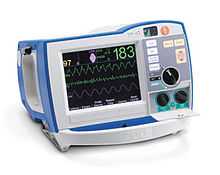Cardiac monitoring
The phrase cardiac monitoring generally refers to continuous monitoring of the heart activity, generally by electrocardiography, with assessment of the patients condition relative to their cardiac rhythm. It is different from hemodynamic monitoring, which monitors the pressure and flow of blood within the circulatory system. The two may be performed simultaneously on critical heart patients. A small monitor worn by an ambulatory patient is known as a Holter monitor. Transmitting data from a monitor to a distant monitoring station is known as telemetry or biotelemetry.
Emergency medical services
In the setting of out-of-hospital acute medical care, ambulance services and other emergency medical services providers utilize heart monitors to assess the patient's cardiac rhythm. Providers licensed or certified at the Intermediate or Paramedic level are qualified to interpret EKGs. The finding of a cardiac dysrhythmia (or for that matter, a normal sinus rhythm) may give additional information about the patients condition or may be a sufficient diagnosis on its own to guide treatment. Treatment for specific cardiac rhythms is guided by ACLS. Basic EMTs are allowed to apply the electrodes and physically operate the monitor but not interpret the rhythm.
In the emergency department
In the emergency department, cardiac monitoring is a part of the monitoring of vital signs in emergency medicine, and generally includes electrocardiography.
Monitor/Defibrillators
Some digital patient monitors, especially those used EMS services, often incorporate a defibrillator into the patient monitor itself. These monitor/defibrillators usually have the normal capabilities of an ICU monitor, but have manual (and usually semi-automatic AED)defibrillation capability. This is particular good for EMS services, who need a compact, easy to use monitor and defibrillator, as well as for inter- or intrafacility patient transport. Most monitor defibrillators also have transcutaneous pacing capability via large AED like adhesive pads (which often can be used for monitoring, defibrillation and pacing)that are applied to the patient in an anterior-posterior configuration. The monitor defibrillator units often have specialized monitoring parameters such as waveform capnography, invasive BP, and in some monitors, Masimo Rainbow SET pulse oximetry. Examples of monitor defibrillators are the Lifepak 12, 15 and 20 made by Physio Control, the Philips Heartstart MRx, and the E Series and R Series by ZOLL Medical.
 A Welch Allyn PIC 50 monitor/defibrillator from an Austrian EMS service. |  A closeup view of the screen of the PIC 50. |  ZOLL R Series Plus external monitor/defibrillator |
Long-term ambulatory monitors
There are two broad classifications for cardiac event monitors: manual (or dumb) and automatic. Automatic ECG event monitors have the ability to monitor the patient's ECG and make recordings of abnormal events without requiring patient intervention. Manual ECG event recorders require the patient to be symptomatic and to activate the device to record an event; this makes these devices useless whilst, for example, the patient is sleeping. A third classification, the implantable loop recorder, provides both automatic and manual abilities.
An example of automatic monitoring is the transtelephonic cardiac event monitor. This monitor contacts ECG technicians, via telephone, on a regular basis transmitting ECG rhythms for ongoing monitoring. The transtelephonic cardiac event monitor can normally store approximately five "cardiac events" usually lasting 30–60 seconds.
Heart rate monitoring
Monitoring of the heart rate can be performed as part of electrocardiography, but it can also be measured conveniently with specific heart rate monitors. Such heart rate monitors are largely used by performers of various types of physical exercise.
Gallery
-

Portable wireless ECG monitor
